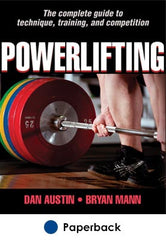Building the Bench Press
This is an excerpt from Powerlifting by Dan Austin & Bryan Mann.
Building the Bench Press
To build the bench, you must do several things. First, train the bench to perfect its technique and build strength in it. If you do not have great technique that is reproducible (every rep looks the same with the bar landing in the same spot every time), then any development done will not be as effective. This is best done under loads over 80 percent of the raw maximum when training raw, and 85 percent of the geared maximum. (The difference is due to the difficulty touching.) Sets of 6 or fewer repetitions at intensities over 75 percent are best to build strength. Anything lighter does not recruit the largest amount of available motor units, thereby leaving some units untapped and undeveloped.
After training the bench, the next step is to build the bench. First build the muscles of the triceps and lats. Think of all the big benchers—Ryan Kennelly, Rob Luyando, Tony Balonognone, and Tiny Meeker. They all have exceptional lat development and exceptional triceps. A chain is only as strong as its weakest link, so someone with pecs, triceps, and shoulders capable of a 700-pound bench but lats capable of only a 500-pound bench will attain only a 500-pound bench.
Build the bench with special exercises that develop the proper muscles. The triceps are made up of three muscles: the lateral, medial, and long heads. Each muscle head serves a different function, so exercises must train the proper function. For instance, pressing is most directly related to the long head, the not pretty looking part of the triceps that is most visible from the bottom of the horseshoe in the center to the elbow. By understanding this, we can see that to develop the bench press, simply selecting a triceps exercise is not sufficient. The exercise must develop the long head of the triceps. The exercises listed here most directly affect and strengthen the long head of the triceps. An exercise such as a kickback may be an excellent triceps exercise for form, bringing out the shape of the horseshoe, creating a sweep on the outer arm by developing the lateral head of the triceps, but is a poor choice for developing the triceps for the bench press, as the long head is neglected.
The latissimus dorsi, or lats, is another muscle group that must be trained. The latissimus dorsi is a tremendously large muscle group that runs nearly the full size of the back. It must be trained at many angles to train the entire muscle. Training the lats is slightly different than training the triceps in that it doesn't really matter the exercise, as long as you go heavy with high volume and the lat development that occurs increases the bench press. Some exercises, such as pull-ups, in which multiple joints and body stabilization are involved, are better than simple machine rows, but any back exercise is good. In fact, Bill Gillespie swears by the magic of pull-ups and notices when his pull-ups drop off that his bench does as well. For him it is imperative to keep his pull-up strength high.
Upper back development is key for two things: increasing stability of the shoulders and improving the arch. The bigger the upper back, the larger the launching pad for the bench press, because the upper back is the part of the body that remains in contact with the weight bench at all times. For equipped bench pressing, the upper back also must be strong enough to maintain form. With many bench shirts, you have to force the shirt around your body in order to press the bar properly, and you get much more out of your shirt this way. If the upper back is not strong enough to keep the shoulder blades pulled together, the shoulder blades open and take the stress away from the shirt and make the lifter have to do more of the pressing than the shirt. This may be considered cheating by some, but it is the way to get the most out of a shirt. Notice all big bench pressers have a quite large and well-developed upper back.
The shoulders must be built up in both the pressing heads (anterior) and supportive heads (posterior) to increase strength and longevity in the sport. Although increasing only the muscles responsible for pressing (the anterior heads of the deltoids) ensures that the bench press goes up, if you do not strengthen the opposite side (the posterior heads of the deltoids), the shoulders are thrown out of balance and injuries are likely to occur. In this case, a weakness in the chain doesn't equate to a lower bench press, it relates to an injury. Look at the exercises that make your bench press go up. Overhead pressing has long been a staple of bench pressers, as it is a great exercise to strengthen the supporting musculature. Other exercises such as lateral raises, plate raises, rear raises, and bent-over lateral raises are good as they build the individual heads of the shoulders, which helps to enforce balance.
The biceps should be trained as well to help with elbow issues that may occur. You can hold biceps training to a minimum due to the function of the biceps in back exercises. Also, the biceps are not being worked to increase strength in the bench press but to prevent injury. Training the biceps is most important to the three-lift competitor due to the astounding prevalence of torn biceps on the deadlift on the underhand of the over under grip technique.
More Excerpts From Powerlifting

Get the latest insights with regular newsletters, plus periodic product information and special insider offers.
JOIN NOW


